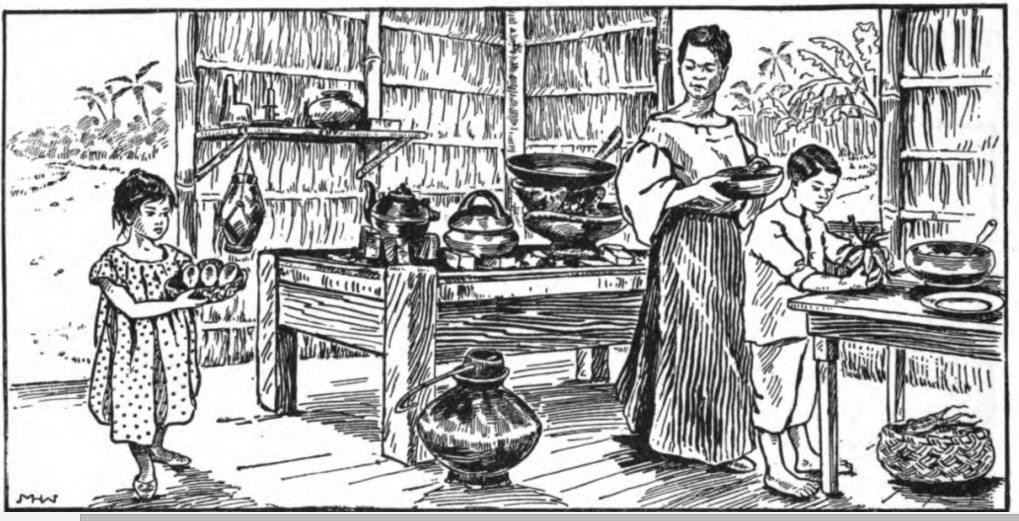
Can you ever imagine living and cooking without electricity or running water? For a very long time, Filipinos cooked with firewood and charcoal in their smoky kitchen.
It was only in 1890 when Sociedad Mercantil provided electricity to Manila and nearby provinces, with the elite of Intramuros as its initial users. In 2023, over 11 million Filipinos or 2.45 million households in remote rural areas still do not have access to electricity.
Early kitchens have stood the test of time, and witnessed all kinds of cooking such as steaming, boiling, sauteing, frying, grilling, and roasting, all done without electricity and refrigeration.
A space solely for cooking inside the house, the word kusina is from the Spanish word cucina, rooted in the Latin coquere, “to cook.” It was also called saingan or sigangan. In Bahasa Indonesia, kitchen is dapur, a Southeast Asian word for ‘open fire’ and the root word of Tagalog’s dapog, or Visayan dapug.

An array of early kitchen implements, mostly handmade and carved out of wood or stone, shaped from clay, woven out of bamboo and rattan, or cut from metal have helped our grandmothers and grandaunts prepare everyday food as well as celebratory dishes, many of which we consider heritage dishes today.
Tools and implements
The first Tagalog dictionary,Vocabulario de la Lengua Tagala (1613), by the Franciscan friar Pedro de San Buenaventura contains over a thousand word entries related to the kitchen and cooking. By 1860, kusina, kusinaan, or pangusinaan were the popular Tagalog terms for kitchen.
With pottery’s existence in the archipelago dated since 5800 B.C., clay stoves and pots remain widespread. Prehistoric earthenware stoves have been found in Sta. Ana, Manila, Laguna, Cagayan, Batangas, and Butuan.

Dapog, abuhan, ulingan, or dalikan in Ilocano and Ibanag: the spot where the kalan is located; it may be a table, a shelf, or a flat surface lined with soil. Other implements include the pang-ihip or tsupan, a bamboo or metal pipe to blow and control the fire; a sipit or tong for moving hot charcoals. The space below is for storing pots and pans or firewood.
Kalan or pugon: an earthenware stove used for cooking. It can be used with charcoal or firewood fed through an opening in front.
The basic clay pot for cooking is the palayok or kulon, spherical and round-bottomed in various shapes, sizes, and uses. A pot with a narrow mouth is for cooking rice; a wide-mouthed one is for soups and stews. Covers are made of clay as well.

For cooking rice, the pot is named saingan or ipusan; golayan for vegetables; laoya for cooking meat; anglit, a small pot for cooking food in small quantities.
Cooking in earthenware pots lined with pandan or banana leaves imparts better flavor to the dish, says traditional cooks.In Batangas, its famous sinaing ng tulingan must be cooked in a palayok.
Steamers for rice cakes are pots with perforations at the bottom; flat ones are used as bibingkahan, clay oven for baking bibingka, with glowing coals on top and below.
Banga or tapayan inTagalog, malabi in Ilocano: clay jar, for storing water and keeping it cool.


Kawa: a large metal vat for cooking in large quantities used in open-air cooking for weddings and fiestas; talyasi: medium-sized cast iron vat; kawali/carajay: a smaller one shaped like a wok with a curved bottom and a handle for sautéing, frying, or braising; tacho: a two-handled copper skillet with a flat bottom used for making syrups and candies. It was the Chinese who produced and sold metal cooking wares in the archipelago early on. Cast iron pots and pans also came from Spain and China.
Serving spoons include sandok for rice and panguot, a scoop for cooked food made of a half coconut shell. Sandok: a coconut shell ladle with bamboo handles of different sizes; sianse: a metal food turner also used as plancha, for searing ham.
Sangkalan: wooden chopping board. Dikin: ring stands made of woven bamboo or rattan for pots.
Bilao/kararaw: a round flat basket usually made of bamboo and rattan for winnowing rice; bistay: smaller than bilao, a flat and wide bamboo sieve with its weaves spaced out a bit, for cleaning beans.
Kudkuran/kabayo: made of a wooden piece where one mounts with a sharpened serrated metal blade attached on one end, for grating coconut.
Gilingan: a stone hand mill for making ground rice or galapong; until the 1930s, cacao beans were mashed into a paste with the use of a roller and granite slab, metate, set at an angle to make homemade tablea for that thick chocolate prepared by using a chocolatera and batidor.
Dikdikan/almires: table-top granite stone mortar and pestle for crushing garlic, peppercorns, and shrimp heads.
Lusong: wooden mortar cut out from a tree trunk for separating rice grains from its husk; it comes with a wooden pestle; for women, smaller in size and much lighter.
Parilya: a small metal grill. Sartin: enamel plates, mugs, and cups.
Antique charm
Today, many of these vintage kitchen implements are found in museums and antique stores with fancy price tags, repurposed as interior design items.



